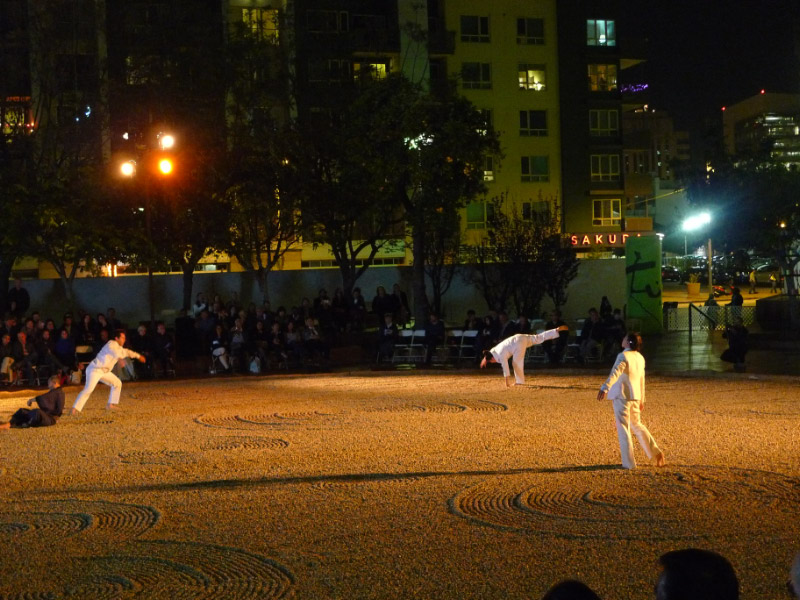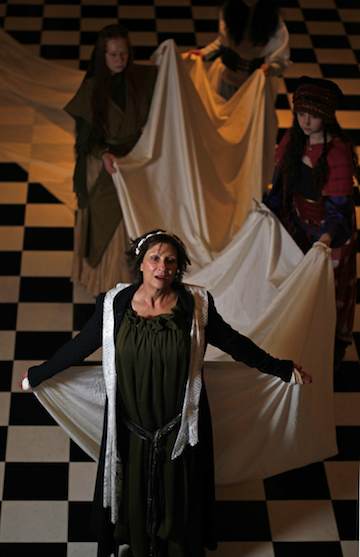What is it about outdoor cultural events that attracts fly-overs by police helicopters?
Concern about masses of people gathering? Making sure artists don’t step out of bounds? Maybe LA’s Finest just want a closer look.
Certainly many people want to take a look when work is site-specific and, for that reason, fleeting, as were two performance events I recently attended in Los Angeles.
A lone man, Butoh dancer Oguri, sits in a giant circle of 5 million pebbles, an immaculately raked Zen garden. As composer Yuval Ron’s haunting music plays, the man sits motionless. This is the beginning of Hirokazu Kosaka’s Mare Nubium, which took place at the Japanese America Cultural & Community Center plaza to inaugurate LA Bloom, a 9-day arts festival celebrating the arrival of Spring.
Mare Nubium proceeds deliberately. Oguri sits in the giant circle, pebbles raked in parallel lines. The music shifts, and a man with a rake enters the sacred space. Carefully he inscribes pebble-circles within in the garden. These inner circles don’t touch until he draws the sixth one is drawn; at that moment of friction, the music shifts again. One senses that drama, and conflict, soon will unfold.
Four more Butoh dancers begin to articulate their way around the garden, eventually stepping within it, as the music becomes percussive clattering. When Oguri stands there’s a crescendo; in agony he surveys the wasteland that surrounds him. By now the other dancers have traversed behind the Zen circle, where 384 spools of colored thread await on wooden racks. Attaching these multi-colored threads to their heads and mouths, they begin a lingering slow procession back across the pebbles, toward a gigantic WWII-vintage spotlight, which blindingly casts its beam.
Oguri soon finds himself within the procession of threads. He staggers against it and tries to move in the opposite direction – much like trying to swim against the sea of time. Eventually the effort is too much and the web too persuasive; he joins the procession.
Hirokazu’s staging is simple and powerful, evocative of time and its inevitable transformation. Marking the time, Yuval Ron’s score clatters and rustles, buzzes like bees, shifts like dry leaves, and peaks as the dancers surrender to an inevitable forward movement.
In Mare Nubium, time never looks back.
* * * * *
Backward, though, is the setting for O-lan Jones’s and Kathleen Cramer’s opera The Woman in the Wall: all the way back to the Middle Ages, although the ambition of this piece is to weave a thread from then to now.
Performed in the Culver City Masonic Lodge in late March, this opera consists of seven scenes spanning 17 years in the life of Marianna, a nun who has volunteered to become an anchoress, which means she will live in a single walled-in room for the rest of her life. One window of her room looks into the convent; the other looks out onto the world.
In each of the scenes she is visited by one or more of the medieval Virtues. In the Lodge’s lobby, images of these same Virtues, inherent to Masonic practice, adorn the walls.
Marianna’s religious commitment allows her to be a confidant for commoners and kings. “If I am dead to life, what am I alive to?” Marianna wonders in the first scene. The world pulls at her, sometimes, but she remains true to her vows, often with the reconciling mediation of the Virtues.
While the first act offers simple imagery, the narrative feels episodic – like the non-perspectival approach taken by medieval painters. The Middle Ages are a particularly difficult era to capture, in both their philosophy and aesthetic – best was Eric Rohmer’s film Perceval, which used 2-dimensional trees and castles to convey a sense of place. The libretto in the first act isn’t quite up to the challenge because it is too aware of the Middle Age’s surfaces; it does not acknowledge the medieval psychology that was, in some respects, more complex than that of the Renaissance.
In the second act, though, the book expands to let us inside Marianna’s psychology – that’s what we have been longing for. Particularly haunting are scenes of Marinna, alone in her cell, and a scene where a townswoman, accused of witchcraft, is burned.
The fact that Marianna cannot stop the witch burning – that she perceives the world but is powerless to affect it – forms the opera’s central conflict. Again, we would relish more – especially as we, contemporary citizens, exist in our self-walled rooms, while our politicians demonize women and seek to encumber their rights.
O-lan Jones’s music soars and glistens, and carries the emotional arc of the story. It is written in a series of modes, medieval scales which sound odd and trippy to the modern ear. Over the evening, the effect was hallucinatory and transporting. “Fathomless waters,” Marianna wails, and that’s what one feels – drawn down into uncertain musical oceans, oceans whose waves are both overwhelming and comforting.
Gretchen Johnson as Marianna displayed a full vocal range and strong grasp of the character’s internal demons. David O music-directed the 8-piece orchestra. It was rather amazing to see this extent of production – staged in a unique venue, supported by 30 chorus members – all in the service of a new work. LA Opera: Why don’t you take this under your wing and give it another production, developing it to its next level? O-lan Jones is a composer who deserves a wider audience.
Images: Top, Mare Numbium, photo by Lori Zimmerman. Below, The Woman in the Wall, photo by Emily Brooke Sandor.


